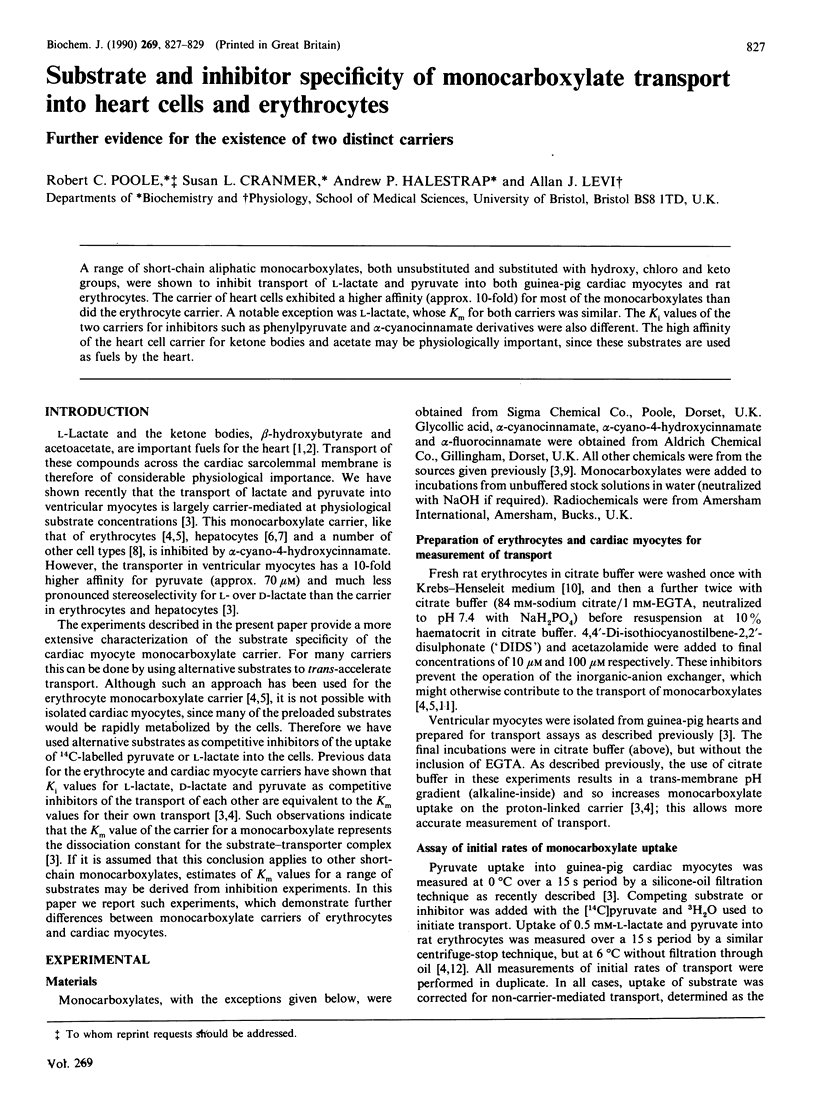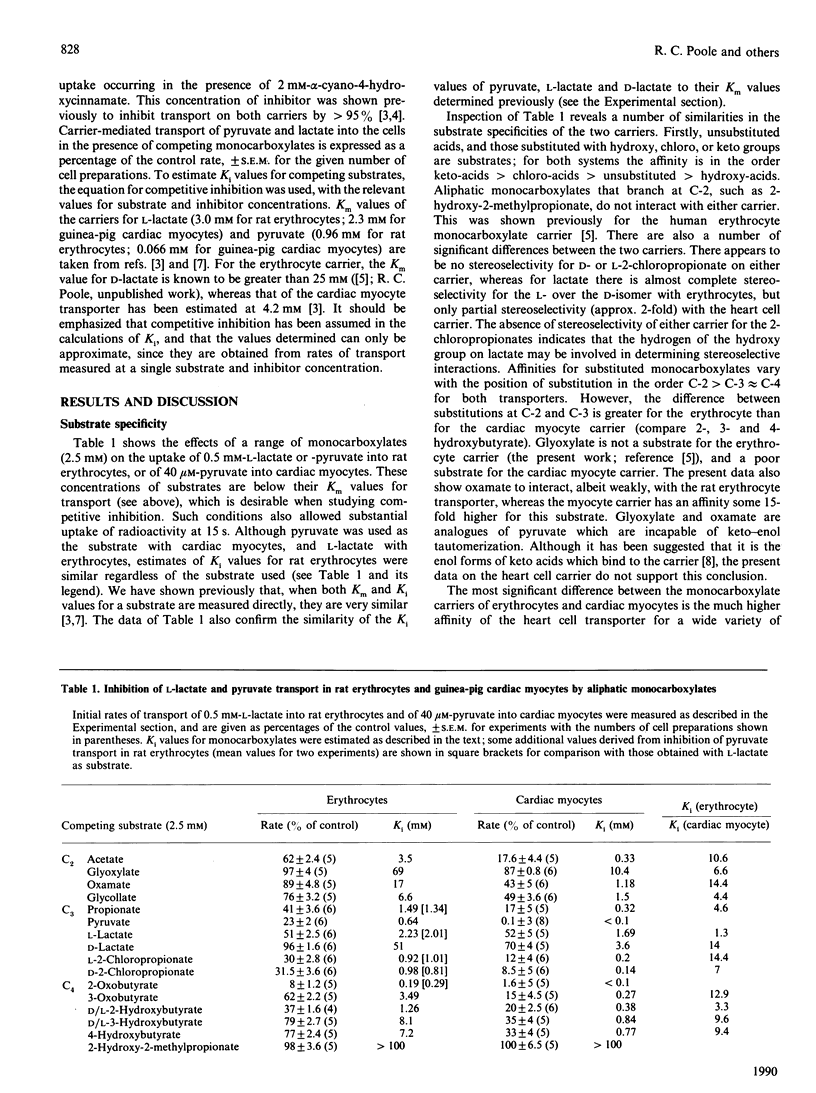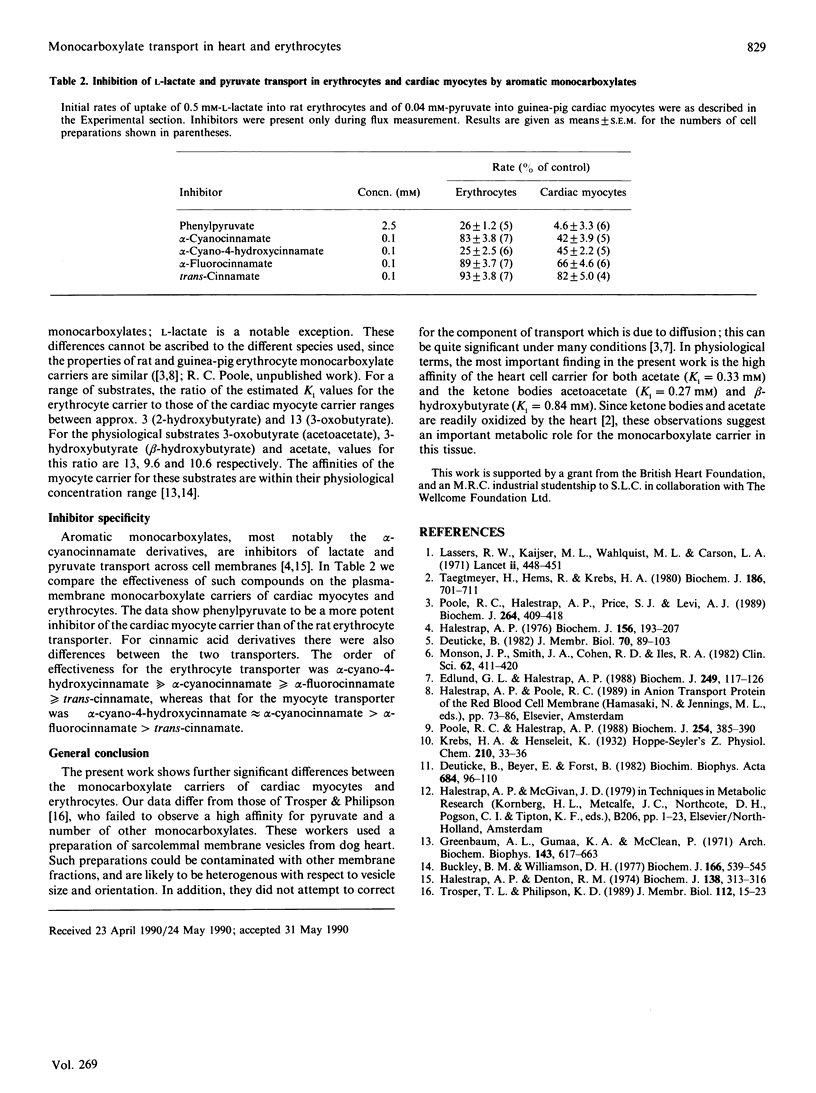Abstract
A range of short-chain aliphatic monocarboxylates, both unsubstituted and substituted with hydroxy, chloro and keto groups, were shown to inhibit transport of L-lactate and pyruvate into both guinea-pig cardiac myocytes and rat erythrocytes. The carrier of heart cells exhibited a higher affinity (approx. 10-fold) for most of the monocarboxylates than did the erythrocyte carrier. A notable exception was L-lactate, whose Km for both carriers was similar. The K1 values of the two carriers for inhibitors such as phenylpyruvate and alpha-cyanocinnamate derivatives were also different. The high affinity of the heart cell carrier for ketone bodies and acetate may be physiologically important, since these substrates are used as fuels by the heart.
Full text
PDF


Selected References
These references are in PubMed. This may not be the complete list of references from this article.
- Buckley B. M., Williamson D. H. Origins of blood acetate in the rat. Biochem J. 1977 Sep 15;166(3):539–545. doi: 10.1042/bj1660539. [DOI] [PMC free article] [PubMed] [Google Scholar]
- Deuticke B., Beyer E., Forst B. Discrimination of three parallel pathways of lactate transport in the human erythrocyte membrane by inhibitors and kinetic properties. Biochim Biophys Acta. 1982 Jan 4;684(1):96–110. doi: 10.1016/0005-2736(82)90053-0. [DOI] [PubMed] [Google Scholar]
- Deuticke B. Monocarboxylate transport in erythrocytes. J Membr Biol. 1982;70(2):89–103. doi: 10.1007/BF01870219. [DOI] [PubMed] [Google Scholar]
- Edlund G. L., Halestrap A. P. The kinetics of transport of lactate and pyruvate into rat hepatocytes. Evidence for the presence of a specific carrier similar to that in erythrocytes. Biochem J. 1988 Jan 1;249(1):117–126. doi: 10.1042/bj2490117. [DOI] [PMC free article] [PubMed] [Google Scholar]
- Greenbaum A. L., Gumaa K. A., McLean P. The distribution of hepatic metabolites and the control of the pathways of carbohydrate metabolism in animals of different dietary and hormonal status. Arch Biochem Biophys. 1971 Apr;143(2):617–663. doi: 10.1016/0003-9861(71)90247-5. [DOI] [PubMed] [Google Scholar]
- Halestrap A. P., Denton R. M. Specific inhibition of pyruvate transport in rat liver mitochondria and human erythrocytes by alpha-cyano-4-hydroxycinnamate. Biochem J. 1974 Feb;138(2):313–316. doi: 10.1042/bj1380313. [DOI] [PMC free article] [PubMed] [Google Scholar]
- Halestrap A. P. Transport of pyruvate nad lactate into human erythrocytes. Evidence for the involvement of the chloride carrier and a chloride-independent carrier. Biochem J. 1976 May 15;156(2):193–207. doi: 10.1042/bj1560193. [DOI] [PMC free article] [PubMed] [Google Scholar]
- Lassers B. W., Kaijser L., Wahlqvist M. L., Carlson L. A. Relationship in man between plasma free fatty acids and myocardial metabolism of carbohydrate substrates. Lancet. 1971 Aug 28;2(7722):448–450. doi: 10.1016/s0140-6736(71)92624-9. [DOI] [PubMed] [Google Scholar]
- Monson J. P., Smith J. A., Cohen R. D., Iles R. A. Evidence for a lactate transporter in the plasma membrane of the rat hepatocyte. Clin Sci (Lond) 1982 Apr;62(4):411–420. doi: 10.1042/cs0620411. [DOI] [PubMed] [Google Scholar]
- Poole R. C., Halestrap A. P., Price S. J., Levi A. J. The kinetics of transport of lactate and pyruvate into isolated cardiac myocytes from guinea pig. Kinetic evidence for the presence of a carrier distinct from that in erythrocytes and hepatocytes. Biochem J. 1989 Dec 1;264(2):409–418. doi: 10.1042/bj2640409. [DOI] [PMC free article] [PubMed] [Google Scholar]
- Poole R. C., Halestrap A. P. Reconstitution of the L-lactate carrier from rat and rabbit erythrocyte plasma membranes. Biochem J. 1988 Sep 1;254(2):385–390. doi: 10.1042/bj2540385. [DOI] [PMC free article] [PubMed] [Google Scholar]
- Taegtmeyer H., Hems R., Krebs H. A. Utilization of energy-providing substrates in the isolated working rat heart. Biochem J. 1980 Mar 15;186(3):701–711. doi: 10.1042/bj1860701. [DOI] [PMC free article] [PubMed] [Google Scholar]
- Trosper T. L., Philipson K. D. Functional characteristics of the cardiac sarcolemmal monocarboxylate transporter. J Membr Biol. 1989 Nov;112(1):15–23. doi: 10.1007/BF01871160. [DOI] [PubMed] [Google Scholar]


